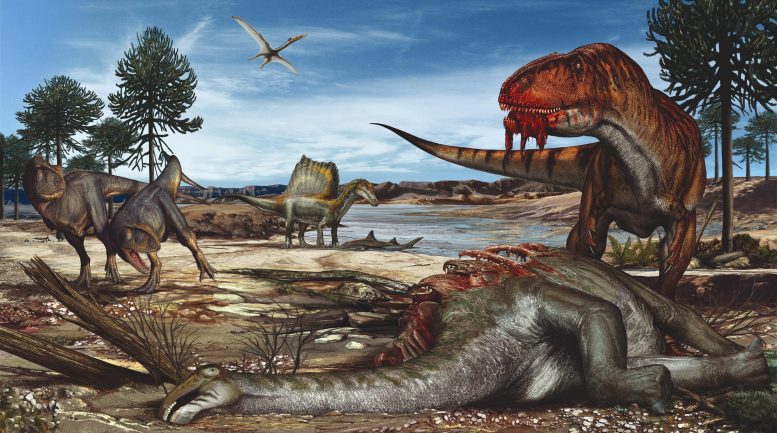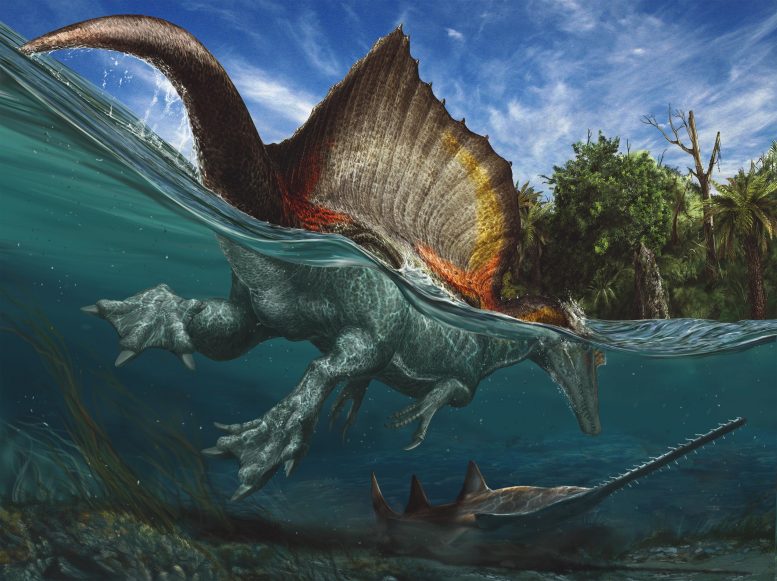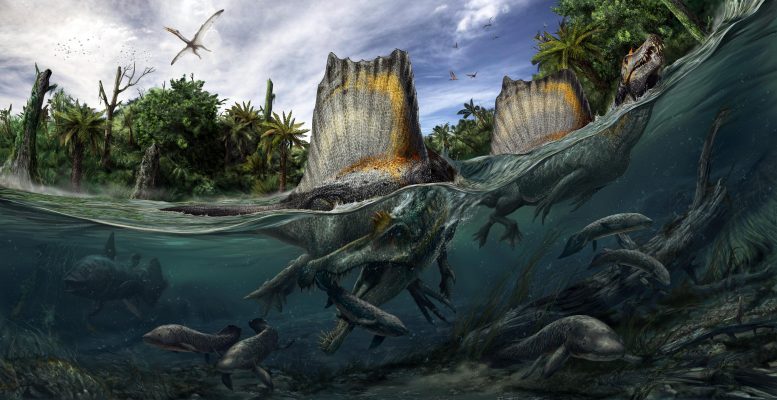
The Kem Kem beds in Morocco are famous for the spectacular fossils found there, including at least four large-bodied non-avian theropods, several large-bodied pterosaurs, and crocodilians.
Now, in a new geology and paleontology monograph, that reveals much more about the famous Kem Kem beds in Morocco, Dr. Nizar Ibrahim from the University of Detroit Mercy, Prof. Paul Sereno from the University of Chicago, and a team of international scholars from the United States, Europe, and Morocco, have put together a comprehensive story that is published in the open-access journal ZooKeys.
The aim of the new research is to provide the international community with an in-depth review of the rocks and fossils of the region. It reviews the geology and paleontology of this famous but surprisingly understudied area, describing and formally naming the strata and summarizing all of the preserved life forms, from fragile plants and insects to massive dinosaurs. The monograph also paints a picture of life as it once was some 95 million years ago by describing the paleoenvironments of the region, and the unusual predator-dominated fauna.

In 1996 Prof. Sereno and colleagues introduced the informal term “Kem Kem beds” for this fossil-rich escarpment. In this monograph, the authors review the original tri-level proposal for the region by French geologist Choubert (his informal “trilogie mésocretacée”) and propose the Kem Kem Group for the entire package of rock with two new names for the dinosaur-bearing layers based on the richest fossil sites, the Gara Sbaa and Douira formations.
The region is famous for the prodigious fossils found in all of these units, many derived from commercial fossil collecting, which obscures the precise location and level of the specimens. The monograph is the first work to pinpoint where many of the most important finds were made. Over the last 25 years in particular, paleontologists have brought to light a diverse array of new vertebrate fossils including at least four large-bodied non-avian theropods, several large-bodied pterosaurs, crocodilians, turtles, and an array of sharks and bony fish.

To put a comprehensive story together on the Kem Kem, the authors of the monograph visited collections of Kem Kem fossils around the world and led many expeditions to the region. Fossil and geological data reviewed in the monograph is derived from a number of different sources. A University of Chicago-led major expedition in 1995 generated a wealth of geological and paleontological data, as did later expeditions involving teams from the University College Dublin, the University of Portsmouth, the Faculté des Sciences Aïn Chock, the Muséum national d’Histoire naturelle, the University Cadi Ayyad, the Museo Civico di Storia Naturale (Milan), and the University of Detroit Mercy.
One of the key features of the Kem Kem assemblage is the presence of several large-bodied theropods, a group of dinosaurs that includes all of the meat-eaters. Most famous among these from the Kem Kem include the sail-backed Spinosaurus and the saber-toothed Carcharodontosaurus.
Most fossils in the Kem Kem region are discovered as isolated fragmentary pieces weathered from sandstones. Only four partial dinosaur skeletons or skulls have been recovered, which include the long-necked sauropod Rebbachisaurus garasbae and the theropods Deltadromeus agilis, Carcharodontosaurus saharicus and Spinosaurus aegyptiacus. These Kem Kem theropods are among the largest known dinosaurian predators on record reaching adult body lengths in excess of 12 meters.
“Given the continued input of new specimens and the continuing expansion of paleontological research, we predict that diversity in the Kem Kem Group will increase substantially in the coming decades. Based on our review of existing collections, this increase will include scores of taxa from the pond locality Oum Tkout including invertebrates, such as plants, insects, and ostracods, as well as an array of actinopterygian fish. We also anticipate a continuing trickle of new terrestrial vertebrates that will be named on better-preserved specimens that are diagnostic at present only at the familial level, including turtles and various kinds of archosaurs. As nearly half of the reptilian families listed are indeterminate, better-preserved specimens will offer future opportunities to recognize new reptilian genera”, share the authors.
“In summary, the Kem Kem assemblage of non-vertebrates and vertebrates is likely to continue to show a dramatic increase in diversity in the coming decades. Nonetheless, the array of taxa currently known, which extends from plants across a range of aquatic and terrestrial vertebrates, is sufficiently mature to allow a summary of the vertebrate assemblage and a discussion of its paleoecological context”, conclude the researchers.
In his earlier research, a famous paleontologist from the University of Chicago Prof. Paul Sereno has described many outstanding dinosaur discoveries, including new Cretaceous crocodilians from the Sahara and two new fanged vegetarian dinosaur dwarfs (called heterodontosaurids).
Reference: “Geology and paleontology of the Upper Cretaceous Kem Kem Group of eastern Morocco” by Nizar Ibrahim, Paul C. Sereno, David J. Varricchio, David M. Martill, Didier B. Dutheil, David M. Unwin, Lahssen Baidder, Hans C. E. Larsson, Samir Zouhri and Abdelhadi Kaoukaya, 21 April 2020, ZooKeys.
DOI: 10.3897/zookeys.928.47517